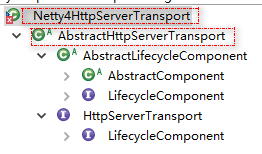1 概述
ElasticSearch支持Restful和NodeClient两种通信方式。如下,TransportClient已经被Rest客户端代替,在8.0中会被移除。
@deprecated {@link TransportClient} is deprecated in favour of the High Level REST client and will be removed in Elasticsearch 8.0.
ES在启动类org.elasticsearch.bootstrap.Bootstrap中会实例化表示一个节点的org.elasticsearch.node.Node类,Node类的构造函数中会进行大量的模块、Service、Plugin等的初始化。
还有一点需要明确的是ES中的Rest和NodeClient都是基于Netty实现的。
2 Restful
2.1 Rest服务启动流程
ElasticSearch发送和接受报文的操作由org.elasticsearch.transport.TransportService类完成,通过跟踪其构造函数的调用栈可以发现在Node的构造函数中实例化了该类:
在TransportService的构造函数中有一个参数Transport,该类是底层通信的关键。
该类在Node中实例化并作为参数传入TransportService的构造函数,Node中实例化代码如下:
final Transport transport = networkModule.getTransportSupplier().get();
继续跟踪到NetworkModule的代码中可以发现getTransportSupplier()返回的是Netty4Plugin,Netty4Pluign.get则返回如下:
() -> new Netty4HttpServerTransport(settings, networkService, bigArrays, threadPool, xContentRegistry, dispatcher)
Node、TransportService以及Transport都实现了AbstractLifecycleComponent类,具有start、stop等生命周期方法,BootStrap在Node初始化完成后,会调用其start方法,Node也在其start方法中调用了Module、Service等的start方法。TransportService.doStart方法如下:
@Override
protected void doStart() {
transport.addMessageListener(this);
connectionManager.addListener(this);
transport.start();//调用transport的start方法
if (transport.boundAddress() != null && logger.isInfoEnabled()) {
logger.info("{}", transport.boundAddress());
for (Map.Entry entry : transport.profileBoundAddresses().entrySet()) {
logger.info("profile [{}]: {}", entry.getKey(), entry.getValue());
}
}
localNode = localNodeFactory.apply(transport.boundAddress());
if (connectToRemoteCluster) {
// here we start to connect to the remote clusters
remoteClusterService.initializeRemoteClusters();
}
}
我们直接看Netty4HttpServerTransport的doStart方法:
@Override
protected void doStart() {
boolean success = false;
try {
serverBootstrap = new ServerBootstrap();
serverBootstrap.group(new NioEventLoopGroup(workerCount, daemonThreadFactory(settings,
HTTP_SERVER_WORKER_THREAD_NAME_PREFIX)));
serverBootstrap.channel(NioServerSocketChannel.class);
//下面的一行配置了有客户端连接时的ChannelInitializer,ChannelInitializer主要用来配置处理客户端报文的Pipeline,下一小节会详述。
serverBootstrap.childHandler(configureServerChannelHandler());
serverBootstrap.handler(new ServerChannelExceptionHandler(this));
serverBootstrap.childOption(ChannelOption.TCP_NODELAY, SETTING_HTTP_TCP_NO_DELAY.get(settings));
serverBootstrap.childOption(ChannelOption.SO_KEEPALIVE, SETTING_HTTP_TCP_KEEP_ALIVE.get(settings));
final ByteSizeValue tcpSendBufferSize = SETTING_HTTP_TCP_SEND_BUFFER_SIZE.get(settings);
if (tcpSendBufferSize.getBytes() > 0) {
serverBootstrap.childOption(ChannelOption.SO_SNDBUF, Math.toIntExact(tcpSendBufferSize.getBytes()));
}
final ByteSizeValue tcpReceiveBufferSize = SETTING_HTTP_TCP_RECEIVE_BUFFER_SIZE.get(settings);
if (tcpReceiveBufferSize.getBytes() > 0) {
serverBootstrap.childOption(ChannelOption.SO_RCVBUF, Math.toIntExact(tcpReceiveBufferSize.getBytes()));
}
serverBootstrap.option(ChannelOption.RCVBUF_ALLOCATOR, recvByteBufAllocator);
serverBootstrap.childOption(ChannelOption.RCVBUF_ALLOCATOR, recvByteBufAllocator);
final boolean reuseAddress = SETTING_HTTP_TCP_REUSE_ADDRESS.get(settings);
serverBootstrap.option(ChannelOption.SO_REUSEADDR, reuseAddress);
serverBootstrap.childOption(ChannelOption.SO_REUSEADDR, reuseAddress);
bindServer();
success = true;
} finally {
if (success == false) {
doStop(); // otherwise we leak threads since we never moved to started
}
}
}
如上,其实就是Netty服务端的启动方法,配置Handler,端口号绑定等。
2.2 Rest请求处理
上面的代码注释中,特别提到了configureServerChannelHandler()函数,该函数代码如下:
public ChannelHandler configureServerChannelHandler() {
//将自己(Transport)作为参数传入构造函数
return new HttpChannelHandler(this, handlingSettings);
}
protected static class HttpChannelHandler extends ChannelInitializer {
private final Netty4HttpServerTransport transport;
private final Netty4HttpRequestHandler requestHandler;
private final HttpHandlingSettings handlingSettings;
protected HttpChannelHandler(final Netty4HttpServerTransport transport, final HttpHandlingSettings handlingSettings) {
this.transport = transport;
this.handlingSettings = handlingSettings;
this.requestHandler = new Netty4HttpRequestHandler(transport);
}
@Override
protected void initChannel(Channel ch) throws Exception {
Netty4HttpChannel nettyHttpChannel = new Netty4HttpChannel(ch);
ch.attr(HTTP_CHANNEL_KEY).set(nettyHttpChannel);
ch.pipeline().addLast("read_timeout", new ReadTimeoutHandler(transport.readTimeoutMillis, TimeUnit.MILLISECONDS));
final HttpRequestDecoder decoder = new HttpRequestDecoder(
handlingSettings.getMaxInitialLineLength(),
handlingSettings.getMaxHeaderSize(),
handlingSettings.getMaxChunkSize());
decoder.setCumulator(ByteToMessageDecoder.COMPOSITE_CUMULATOR);
//编码器、压缩器、解码器的设置
ch.pipeline().addLast("decoder", decoder);
ch.pipeline().addLast("decoder_compress", new HttpContentDecompressor());
ch.pipeline().addLast("encoder", new HttpResponseEncoder());
final HttpObjectAggregator aggregator = new HttpObjectAggregator(handlingSettings.getMaxContentLength());
aggregator.setMaxCumulationBufferComponents(transport.maxCompositeBufferComponents);
ch.pipeline().addLast("aggregator", aggregator);
if (handlingSettings.isCompression()) {
ch.pipeline().addLast("encoder_compress", new HttpContentCompressor(handlingSettings.getCompressionLevel()));
}
if (handlingSettings.isCorsEnabled()) {
ch.pipeline().addLast("cors", new Netty4CorsHandler(transport.corsConfig));
}
ch.pipeline().addLast("pipelining", new Netty4HttpPipeliningHandler(transport.logger, transport.pipeliningMaxEvents));
//这里是注册对请求Request进行处理的handler,requestHandler在其构造函数中被初始化为Netty4HttpRequestHandler(transport)
ch.pipeline().addLast("handler", requestHandler);
transport.serverAcceptedChannel(nettyHttpChannel);
}
@Override
public void exceptionCaught(ChannelHandlerContext ctx, Throwable cause) throws Exception {
ExceptionsHelper.maybeDieOnAnotherThread(cause);
super.exceptionCaught(ctx, cause);
}
}
Rest服务端(也就是处理客户端请求的节点),收到报文处理的逻辑主要在上面的Netty4HttpRequestHandler(transport)中,该类实现了netty的inboundhandler
class Netty4HttpRequestHandler extends SimpleChannelInboundHandler>
实现的函数channelRead0用来处理请求报文,其中关键代码为:
serverTransport.incomingRequest(httpRequest, channel);
serverTransport就是我们通过构造传入的Netty4HttpServerTransport实例,其继承关系如下图:
Netty4HttpRequestHandler.channelRead0->
AbstractHttpServerTransport.incomingRequest->
handleIncomingRequest->dispatchRequest
最后dispatchRequest的实现如下:
// Visible for testing
void dispatchRequest(final RestRequest restRequest, final RestChannel channel, final Throwable badRequestCause) {
final ThreadContext threadContext = threadPool.getThreadContext();
try (ThreadContext.StoredContext ignore = threadContext.stashContext()) {
if (badRequestCause != null) {
dispatcher.dispatchBadRequest(restRequest, channel, threadContext, badRequestCause);
} else {
dispatcher.dispatchRequest(restRequest, channel, threadContext);
}
}
}
通过查看方法的调用轨迹可以知道dispatcher为RestController实例,该类类似于SpringMVC的Controller,负责(method,path)->RestHandler的映射,最后会根据method(指Http方法,GET、POST、DELETE、PUT、POST等)以及路径来找到注册的RestHandler,并使用此RestHandler来处理该请求。
首先看RestController.dispatchRequest方法定义:
@Override
public void dispatchRequest(RestRequest request, RestChannel channel, ThreadContext threadContext) {
...
tryAllHandlers(request, channel, threadContext);
...
}
void tryAllHandlers(final RestRequest request, final RestChannel channel, final ThreadContext threadContext) throws Exception {
for (String key : headersToCopy) {
String httpHeader = request.header(key);
if (httpHeader != null) {
threadContext.putHeader(key, httpHeader);
}
}
// Request execution flag
boolean requestHandled = false;
if (checkErrorTraceParameter(request, channel) == false) {
channel.sendResponse(
BytesRestResponse.createSimpleErrorResponse(channel, BAD_REQUEST, "error traces in responses are disabled."));
return;
}
// Loop through all possible handlers, attempting to dispatch the request
//依次迭代所有匹配上方法、路径的Handler
Iterator allHandlers = getAllHandlers(request);
for (Iterator it = allHandlers; it.hasNext(); ) {
final Optional mHandler = Optional.ofNullable(it.next()).flatMap(mh -> mh.getHandler(request.method()));
requestHandled = dispatchRequest(request, channel, client, mHandler);
if (requestHandled) {
break;
}
}
// If request has not been handled, fallback to a bad request error.
if (requestHandled == false) {
handleBadRequest(request, channel);
}
}
boolean dispatchRequest(final RestRequest request, final RestChannel channel, final NodeClient client,
final Optional mHandler) throws Exception {
...
//对于找到的Handler,调用其handleRequest方法
wrappedHandler.handleRequest(request, responseChannel, client);
...
}
下面说一下RestController中handler的注册过程,其实RestController实例化调用如下:
Node构造函数中实例化ActionModule
->ActionModule构造函数中会new RestController
最后Node会调用ActionModule的actionModule.initRestHandlers方法在RestController中注册handler,所有的handler子类都会在自己的构造函数中向controller中注册自己,比如:
public RestMainAction(Settings settings, RestController controller) {
super(settings);
controller.registerHandler(GET, "/", this);
controller.registerHandler(HEAD, "/", this);
}
controller其实是使用Trie树(字典树)维护handler的。
上面接受到请求然后找到合适的handler,最后会调用handler的handleRequest方法,该方法在其父类BaseRestHandler中定义:
@Override
public final void handleRequest(RestRequest request, RestChannel channel, NodeClient client) throws Exception {
// prepare the request for execution; has the side effect of touching the request parameters
//prepareRequest在具体的子类中实现,具体的为根据不同的子类,返回不同的Action,如下面RestSearchAction的实现
final RestChannelConsumer action = prepareRequest(request, client);
// validate unconsumed params, but we must exclude params used to format the response
// use a sorted set so the unconsumed parameters appear in a reliable sorted order
final SortedSet unconsumedParams =
request.unconsumedParams().stream().filter(p -> !responseParams().contains(p)).collect(Collectors.toCollection(TreeSet::new));
// validate the non-response params
if (!unconsumedParams.isEmpty()) {
final Set candidateParams = new HashSet<>();
candidateParams.addAll(request.consumedParams());
candidateParams.addAll(responseParams());
throw new IllegalArgumentException(unrecognized(request, unconsumedParams, candidateParams, "parameter"));
}
usageCount.increment();
// execute the action
action.accept(channel);
}
//比如RestSearchAction的实现如下:
@Override
public RestChannelConsumer prepareRequest(final RestRequest request, final NodeClient client) throws IOException {
SearchRequest searchRequest = new SearchRequest();
/*
* We have to pull out the call to `source().size(size)` because
* _update_by_query and _delete_by_query uses this same parsing
* path but sets a different variable when it sees the `size`
* url parameter.
*
* Note that we can't use `searchRequest.source()::size` because
* `searchRequest.source()` is null right now. We don't have to
* guard against it being null in the IntConsumer because it can't
* be null later. If that is confusing to you then you are in good
* company.
*/
IntConsumer setSize = size -> searchRequest.source().size(size);
request.withContentOrSourceParamParserOrNull(parser ->
parseSearchRequest(searchRequest, request, parser, setSize));
return channel -> client.search(searchRequest, new RestStatusToXContentListener<>(channel));
}
handleRequest最后会调用action.accept,最终会调用client.search(),通过跟踪调用轨迹可以,cient为RestController中的成员变量client,是通过Node实例化ActionModule传入的NodeClient对象。
可以看下NodeClient的search方法,在其父类AbstractClient定义如下:
@Override
public void search(final SearchRequest request, final ActionListener listener) {
execute(SearchAction.INSTANCE, request, listener);
}
好了,其实通过跟踪可以知道,最终会调用NodeClient的方法如下:
public < Request extends ActionRequest,
Response extends ActionResponse
> Task executeLocally(Action action, Request request, ActionListener listener) {
return transportAction(action).execute(request, listener);
}
上面代码中的SearchAction.INSTANCE其实是一个key,NodeClient同样会在ActionModule中注册key对应的TransportAction,具体可以看ActionModule.setupActions方法,这里不再赘述。
TransportAction各子类则负责具体的get, index, search, delete, reroute等的处理。
3 RPC NodeClient
其实分析到这里已经结束了,NodeClient的search, get, delete等函数都是通过key找到TransportAction的子类进行处理。
4 注意
注意ElasticSearch Rest/RPC 接口解析中提到的Transport*Action两层映射关系
